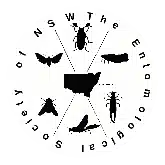Contents Vol. 52 (Public)
These papers are currently only available to members of the Entomological Society of New South Wales, or directly from the author. Once the entire Journal 51 is published they will also be available through Informit. They will be made freely available to all via this website once volume 52 is published in its entirety (approximately one year later). Members should log in from the main menu (found under Membership drop-down menu) to access these papers.
GENERAL AND APPLIED ENTOMOLOGY
The Journal of the Entomological Society of New South Wales Inc.
VOLUME 52
CONTENTS
Rise and demise of chemical used for Australian grain protection with a focus on New South Wales
Ryan, R. & Dominiak, B.C.
Malathion is a key insecticide for the treatment of stored grain pests but its continued use patterns are under review by regulatory authorities. In this literature review, we reflect on grain storage protection issues in Australia but with a focus on New South Wales. Any grain stored for extended times is likely to become infested with storage insect pests. We review storage and export issues in early Australia and observe the challenges and changes created by two world wars, the depression and boom production years. Modern grain protection started with the use of malathion, however the detection of malathion resistance necessitated the introduction of other insecticide options. Fumigants were developed but these also suffered from the onset of resistance. The efficacy of insecticides and fumigants could be improved through combination with other gases or insecticides with different modes of action. Finally, we review the pesticides registered for grain insect pest control and speculate on prospects for grain protection.
General and Applied Entomology 52: 1-11 (published on-line 16.3.2024)
SCIENTIFIC NOTE- Education is the key to success; the learning journey of parasitoid wasps
Oakman, E.
The learning journey for parasitoid wasps to find their host is unique to species. All parasitoid wasps need exposure to the correct plant volatile compound, so that they can learn how to find their hosts as adults. Depending on the wasp species, they may require multiple exposure events throughout their life cycle. Aphidius ervi, for example, is a species that requires two exposure events, whereas Hyssopus pallidus only requires one. Due to species differences, these learning opportunities must be tailored to species.
It’s important to understand this, because in artificial rearing conditions, incorrect or absent learning opportunities results in subpar integrative pest management.
General and Applied Entomology 52: 12-14 (published on-line 22.4.2024)
Nectar-robbing behaviour by honey bees on Alstroemeria psittacina
Hales, D.
Nectar-robbing behaviour by honey bees, Apis mellifera L., was observed on parrot lilies, Alstroemeria psittacina Lehm., in a garden in Beecroft NSW in December 2022. Bees approaching the base of the flower alighted briefly and inserted their mouthparts between the petals and sepals, but no biting behaviour was observed. In a survey of flowers, about half were found to have sections bitten out of the base of petals, the most likely agents being small black ants. Despite the extensive nectar-robbing, pollination of the flowers was successful in nearly all cases, indicating that nectar-robbing had no detrimental effect. The structure and development of the flowers were studied and it was notable that the stamens retained their pollen caps until they hung below the opening of the corolla, making unaided self-pollination unlikely. Individual bees approached the mouth or the base of the flowers.
Experiments set up in November 2023 did not clarify whether the bees were robbers, thieves or both, because of the scarcity of bees following Varroa mite introduction. Pollination rates were lower than in the previous season. I concluded that both bees and ants were nectar robbers. Their behaviour did not affect pollination in 2022, but pollination was reduced in late 2023 when bee numbers were low.
General and Applied Entomology 52: 15-19 (published on-line 22.4.2024)
Oxygen consumption of mass-reared Queensland Fruit Fly Bactrocera tryoni (Froggatt) pupae in sealed plastic bags
Ekman, J., Fanson, B.G. and Dominiak, B.C.
The sterile insect technique (SIT) has been used for more than 50 years to manage a range of insects around the world. SIT is becoming a major component of many area-wide fruit fly management programs. Irradiation of immature life stages induces sterility in adults, and after a pre-release holding period, the emerged adults are distributed over large areas to mate with wild flies, resulting in no viable offspring. However, irradiation in normal air (about 21% oxygen (O2)) results in declining adult quality. To optimise the quality of sterile adult flies, pupae are sealed in plastic bags for a pre-determined period before irradiation. It was assumed that this improved tolerance to irradiation due to depletion of O2 inside the bags, thereby reducing metabolic activity of the pupae. In our trials, we measured the respiration rates for up to 84 minutes of Queensland fruit fly (Qfly), Bactrocera tryoni (Froggatt) (Diptera: Tephritidae) pupae inside sealed containers at 17°C and 27°C and before and after irradiation (four treatments). Respiration was minimised (<1ml.kg-1.h-1) at approximately 3% and 5.6% O2 at 27°C and 17°C respectively. The model indicated that a standard barrier film bag containing 800g bag of Qfly pupae and 100ml headspace would fall to 6% O2 within approximately 3h at 17°C but only 30 minutes at 27°C. Irradiation both suppressed and increased variability of O2 consumption, with the greatest effects at 60-65 and 70-75 Gy in atmospheres close to air. This is consistent with previous observations that irradiation disrupts metabolic activity, reducing development rates and increasing variability of eclosion. Suppression of metabolic activity at relatively high O2 partial pressures likely reflects a key role for CO2 in suppressing pupal respiration. Our results are discussed in terms of optimising pupal fitness by reducing metabolic activity during irradiation, while avoiding negative impacts due to extended periods of O2 deprivation.
General and Applied Entomology 52: 21-27 (published on-line 22.4.2024)
BOOK REVIEW- Australian Jewel Beetles by Williams, Williams and Sundholm
Gunning, R.
General and Applied Entomology 52: 29 (published on-line 22.4.2024)
